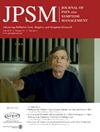在接受阿片类药物治疗癌症疼痛的患者中,患者处方协议对异常尿检的影响
IF 3.5
2区 医学
Q2 CLINICAL NEUROLOGY
引用次数: 0
摘要
最佳实践建议使用患者处方协议(PPA)来改善患者依从性并减少阿片类药物治疗期间的非医疗阿片类药物使用(NMOU),但缺乏证据。没有研究检验过它对癌症患者的疗效。我们研究了PPA完成后3个月和6个月内,PPA完成对异常尿药检(UDT)(一种NMOU指标)的影响。方法:回顾性分析连续接受阿片类药物治疗癌症疼痛并完成PPA的患者的人口学和临床信息,并与未完成PPA的患者进行比较。使用单变量和多变量回归模型来确定与异常UDT相关的因素。结果:符合条件的患者中,分别有126/236(53%)和150/236(64%)在3个月和6个月内获得UDT结果;其中,92/126(73%)和107/150(71%)的患者签署了PPA。PPA完成与3个月内异常UDT发生率显著降低相关(OR 0.28, 95% CI: 0.09, 0.76;p = 0.02)。更高的基线疼痛表达(OR 1.22, 95% CI: 1.04, 1.46;p=0.02),较高的吗啡当量日剂量(OR 1.07, 95% CI: 1.02, 1.14;p=0.02),以及非法药物使用史(OR8.39, 95% CI: 3.31, 23.57;p< 0.001)与ppa完成后3个月内异常UDT相关,且在6个月时仍然显著。结论:与未签署PPA的患者相比,签署PPA的患者在接下来的3个月内异常UDT的发生率显著降低。研究结果表明,PPA可能会减少NMOU行为,突出其作为风险缓解策略的潜力。本文章由计算机程序翻译,如有差异,请以英文原文为准。
Impact of Patient Prescriber Agreement on Aberrant Urine Drug Tests Among Patients Receiving Opioids for Cancer Pain
Context
Best practices recommend the use of patient prescriber agreement (PPA) to improve patient adherence and reduce nonmedical opioid use (NMOU) during opioid therapy but evidence for this is lacking. No study has examined its efficacy among patients with cancer.
Objectives
We examined the impact of PPA completion on aberrant urine drug test (UDT), an NMOU indicator, within 3 and 6 months post-PPA completion.
Methods
Demographic and clinical information of consecutive patients receiving opioids for cancer pain who completed a PPA were retrospectively reviewed and compared with those without a PPA. Univariable and multivariable regression models were used to determine factors associated with aberrant UDT.
Results
126/236 (53%) and 150/236 (64%) of eligible patients had UDT results within 3 and 6 months respectively; among these patients, 92/126 (73%) and 107/150 (71%) signed a PPA. PPA completion was associated with significantly lower rates of an aberrant UDT within 3 months (OR 0.28, 95% CI: 0.09, 0.76; P = 0.02). Higher baseline pain expression (OR 1.22, 95% CI: 1.04, 1.46; P = 0.02), higher Morphine Equivalent Daily Dose (OR 1.07, 95% CI: 1.02, 1.14; P = 0.02), and history of illicit drug use (OR8.39, 95% CI: 3.31, 23.57; P < 0.001) were associated with aberrant UDT within 3 months post-PPA completion and remained significant at 6 months.
Conclusion
Patients who signed a PPA had significantly lower rates of aberrant UDT within the following 3 months compared to patients who did not. The findings suggest that PPA may decrease NMOU behaviors, highlighting its potential as a risk mitigation strategy.
求助全文
通过发布文献求助,成功后即可免费获取论文全文。
去求助
来源期刊
CiteScore
8.90
自引率
6.40%
发文量
821
审稿时长
26 days
期刊介绍:
The Journal of Pain and Symptom Management is an internationally respected, peer-reviewed journal and serves an interdisciplinary audience of professionals by providing a forum for the publication of the latest clinical research and best practices related to the relief of illness burden among patients afflicted with serious or life-threatening illness.

 求助内容:
求助内容: 应助结果提醒方式:
应助结果提醒方式:


